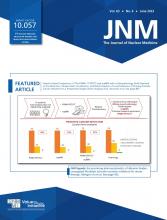Johannes Czernin
Jeremie Calais
Lutetium-177-PSMA-617 (PLUVICTO) has been approved by the U.S. Food and Drug Administration for patients with prostate-specific membrane antigen (PSMA)–positive metastatic castration-resistant prostate cancer (mCRPC) who have been treated with androgen receptor (AR) pathway inhibition and taxane-based chemotherapy (1). This great success was enabled by the design, execution, and results of the VISION trial (2) and has been awaited with great excitement by patients, their families, and treatment teams.
We have previously provided some simplified business forecasts for nuclear theranostics (3). We are expecting a high demand for prostate-specific membrane antigen (PSMA)–targeted molecular radiotherapy initially—a demand that will further increase as indications expand to earlier disease stages. The randomized phase 2 TheraP trial suggested that 177Lu-PSMA-617 may achieve better prostate-specific antigen responses and progression-free survival than taxanes (cabazitaxel) as second-line therapy in patients with metastatic castration-resistant prostate cancer who progress after docetaxel (4). Several other clinical trials exploring the role of PSMA-targeted molecular radiotherapy, ranging from the neoadjuvant setting to the hormone-sensitive setting to first-line therapy for metastatic castration-resistant prostate cancer, are ongoing or about to start (5).
Theranostic centers will also take care of patients with thyroid cancer; neuroendocrine tumors, including paraganglioma and pheochromocytoma; and other cancer types in the future.
How and where will we be able to provide the best care for our patients?
First, we must establish competence. Implementing training and accreditation standards is an essential prerequisite. Two articles, one from experts in Australia and the other from the European Association of Nuclear Medicine, the Society of Nuclear Medicine and Molecular Imaging, and the International Atomic Energy Agency, will soon be published in The Journal of Nuclear Medicine and provide guidance.
Second, we must create a robust supply chain. Given the limited production capacities that are further at risk by the current geopolitical uncertainties, a robust supply chain of therapeutic isotopes is critically important. Failure to deliver therapies reliably will reliably deliver failure of the approach. This is both a challenge and an opportunity for industry and academia, as new production strategies could be developed jointly.
Third, we must establish a large number of theranostic centers. The incidence of neuroendocrine tumors is increasing, being currently estimated at 12,000–15,000 new cases per year in the United States, with an estimated prevalence of 170,000 cases (6). Half the newly diagnosed patients will undergo surgery, but many will experience slowly progressing disease. As a conservative estimate, and assuming that late-stage rather than earlier-stage patients are treated, around 7,500 patients per year might benefit from therapy with 177Lu-DOTATATE (Lutathera; Advanced Accelerator Applications). Patients usually undergo 4 cycles, which translates into 30,000 cycles per year in the United States (Table 1).
Conservative Estimates for Number of Treatment Cycles per Year in United States
Most patients who have end-stage prostate cancer and progress after chemotherapy are potential candidates for PSMA-targeted molecular radiotherapy (∼ 40,000 patients per year) (7). PSMA PET screening may exclude 6,000 of these 40,000 patients (15%) from 177Lu-PSMA therapy (8). We assume that the 50% of patients who are nonresponding would discontinue treatment after 2 cycles whereas the responders would complete the 4–6 scheduled cycles. Thus, we estimate that 34,000 patients will need a total of around 120,000 treatment cycles.
Taken together, 41,500 patients would require 150,000 treatment cycles of lutetium-based molecular radiotherapy per year for metastatic neuroendocrine tumors and prostate cancer (Table 1). At least 70 treatment sites, each providing 8 cycles per day, would be required to deliver approximately 150,000 cycles (assuming 260 workdays in the United States). Currently, a much lower site capacity is expected. Table 2 provides the number of centers required if each site delivers 2, 4, or 8 cycles per day.
How Many Centers Are Needed in United States to Deliver 150,000 Treatment Cycles per Year?
Theranostics have arrived as an important component of precision oncology. Theranostics-based precision oncology requires substantial investments in the supply chain, in training (physicians, nurses, technologists, dosimetrists, radiation safety experts), in site design, in needs assessments, and in operational workflows. Professional organizations need to negotiate appropriate compensation and reimbursement with public and private insurance companies. The first year after Food and Drug Administration approval of PSMA-targeted theranostics will inform us about the initial demand for services. However, because of the predicted rapid future growth, we need to get ready now.
- © 2022 by the Society of Nuclear Medicine and Molecular Imaging.









